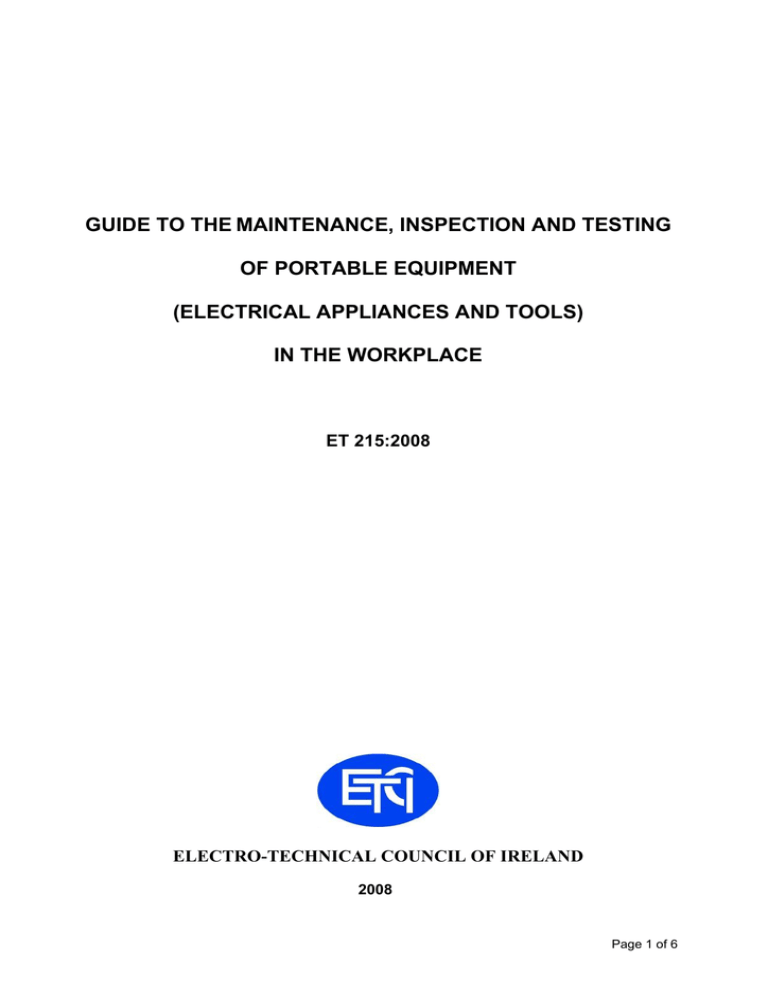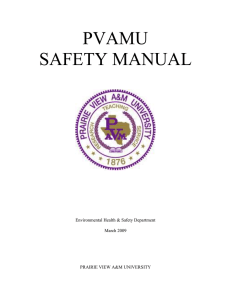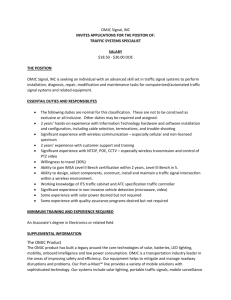
GUIDE TO THE MAINTENANCE, INSPECTION AND TESTING
OF PORTABLE EQUIPMENT
(ELECTRICAL APPLIANCES AND TOOLS)
IN THE WORKPLACE
ET 215:2008
ELECTRO-TECHNICAL COUNCIL OF IRELAND
2008
Page 1 of 6
Published by Electro-Technical Council of Ireland Limited
© The Electro-Technical Council of Ireland 2008. All rights reserved. This material may not be reproduced,
transmitted or stored in paper, electronic (including, but not limited, to any online service, any database or
any part of the internet), CD-Rom or other off-line product or in any other format in any way whatsoever
without the prior written permission of the ETCI.
Electro-Technical Council of Ireland Limited,
Unit H12,
Centrepoint Business Park,
Oak Road,
Dublin 12
Telephone:
Fax:
E-mail:
Website:
(01) 4290088
(01) 4290090
info@etci.ie
http://www.etci.ie
Whilst every effort has been made to ensure that this Guide provides accurate and expert guidance, it is
impossible to predict all the circumstances in which they may be used. Accordingly the authors, the
publishers – ETCI, its committees and members shall not be liable to any person or entity with respect to
any loss or damage caused or alleged to be caused directly or indirectly by omissions, content or any error
contained in this Guide.
Note: For convenience, extracts from the 2005 Safety, Health and Welfare at Work Act and the Safety,
Health and Welfare at Work (General Application) Regulations (S.I. No. 299 of 2007 and S.I. No. 732 of
2007) are set out in italic type, while the guidance is set in normal type.
Page 2 of 6
1. Introduction
This Guide provides practical advice on the maintenance, inspection and testing of portable electrical
equipment in the workplace. The Guide specifically seeks to provide advice to help employers to meet their
statutory obligations. The Guide details a series of measures which should be taken to mitigate dangers
from items of portable equipment which are deployed in the workplace.
2. The Safety, Health & Welfare at Work Act 2005 requires, among other provisions that employers ensure,
so far as is reasonably practicable, the design, provision and maintenance of plant and machinery and any
other articles are safe and without risk to health.
The Safety, Health and Welfare at Work (General Application) Regulations 2007 (S.I. 299 of 2007)
came into operation on 1 November 2007. An amendment (S.I. 732 of 2007) to these regulations came into
operation on 12th. November 2007) Regulation 74 (Interpretation) of these Regulations defines portable
equipment as follows:
“portable equipment” means equipment, including hand-held portable equipment, which:
a) because of the manner in which it is to be used, requires to be moved while it is working,
b) is designed so that it can be moved while it is working, or
c) is moved from time to time between the periods during which it is working;
Regulation 81 (Portable Equipment) of these Regulations, as amended by the Safety, health and Welfare
at Work (General Application) (Amendment) Regulations 2007 (S.I. No.732 of 2007), deals with the
requirements for portable equipment and is stated as follows:
81(1)
An employer shall ensure that—
(a) a circuit supplying portable equipment or a socket outlet intended to supply portable equipment,
including any circuit supplied by an electrical generator, and in which is used alternating current at a
voltage—
(i)
exceeding 125 volts, and
(ii)
not exceeding 1,000 volts,
is protected by one or more residual current devices having a tripping current not exceeding 30
milliamperes operating within such period of time so as to provide the necessary protection to prevent
danger to any person coming into direct or indirect contact with any live part of the circuit,
(b) portable equipment is maintained in a manner fit for safe use, and
(c) portable equipment which is—
(i)
exposed to conditions causing deterioration liable to result in danger, and
(ii)
supplied at a voltage exceeding 125 volts alternating current,
is—
(I)
visually checked by the user before use, and
(II) periodically inspected by a competent person, appropriate to the nature, location and use of
the equipment.
81(2) An employer shall ensure, where appropriate, that a competent person—
(a) tests any portable equipment described in paragraph (1)(c)(i) and (ii), and
(b) certifies whether or not the portable equipment (including any cables and plugs) was, on the day of
test, as far as could reasonably be ascertained, safe and without risk to persons coming into direct or
indirect contact with any live part of the equipment.
Page 3 of 6
81(3) If the certificate of the competent person referred to in paragraph (2) indicates that the portable
equipment tested was not, on the day of the test, safe and without risk, as described in that
paragraph, the employer shall ensure that the equipment is not used until it is made safe and certified
as such in compliance with paragraph (2).
81(4) An employer shall ensure that—
(a) portable equipment, other than portable transformers and portable generators, supplied at a voltage
exceeding 125 volts alternating current is not used in—
(i)
construction work,
(ii)
external quarrying activities, or
(iii) damp or confined locations,
unless its rating exceeds 2 kilovolt amperes,
(b) portable hand lamps supplied at a voltage exceeding 25 volts alternating current or 50 volts direct
current are not used in—
(i)
construction work,
(ii)
external quarrying activities, or
(iii) damp or confined locations, and
(c) where a transformer or engine-driven generator is used to supply electricity to portable equipment at a
voltage greater than 25 volts, but not exceeding 125 volts, alternating current, the neutral (star) point
of the secondary windings of three-phase transformers and generators, or the midpoint of the
secondary windings of single-phase transformers and generators, shall be connected to earth and in
the case of transformers these shall be of the double wound isolating type.
3. Guidance
The following guidance is given to help employers fulfil their statutory requirements.
3.1 Use of Portable Equipment: Portable Equipment should be used in accordance with manufacturers’
instructions and be used for its intended purpose.
3.2
Maintenance: (all portable equipment)
The IEC Electropedia defines maintenance as ‘the combination of all technical and administrative
actions, including supervision actions, intended to retain an item in, or restore it to, a state in which it can
perform a required function’. As for any work equipment, follow the manufacturer’s instructions. As a
minimum:
• Store it in a careful manner when not in use,
• Transport it in a secure manner (so as not subject to unnecessary shocks or vibrations)
• Use it in its intended manner, in its intended environment and never overload it,
• Use correctly rated protective devices and never by-pass these devices.
Keep records of inspections and any tests carried out by competent persons*.
3.3 Visual checking by the user before use: (recommended for all portable equipment)
One of the most important checks that can be carried out on a piece of equipment, particularly
portable appliances or hand-held tools, is the visual inspection. Before using any portable
Page 4 of 6
equipment, the user should ensure that it is correctly rated for use in the proposed location and
environment. Then visually check that it is safe to use, with no signs of damage or defects.
Users must be instructed in the method of carrying out these checks.
Check:
•
Tool/Appliance: Is the on/off switch working correctly? Is there any sign of damage to casing? Are
there any loose parts or missing screws? Is there evidence of overheating or moisture?
Examine its voltage rating to ensure that it is the right voltage for the purpose (e.g. 110 volt hand
tools for construction sites) and the appropriate plug-top for that voltage.
Are live parts properly guarded, so as not to be inadvertently accessible?
•
Cable/mains lead: It should be securely anchored to the plug and to the appliance/tool, with no
signs of cuts, fraying, brittle cable, leads kinked or coiled, taped joints or overloading (overheating
indicated by colour change or smell). Cable cores should not be externally visible.
•
Plug: The cable should be securely anchored, with no signs of cracked casing, overheating, loose or
bent pins.
•
Socket-outlet: Is it free from cracks or other damage? Are there any signs of overheating?
If the ‘user-checks’ indicate that the tool/appliance is faulty or defective, or if a fault occurs during
subsequent use, the tool/appliance should be taken out of service. It should not be used again until the
fault has been repaired and the tool/appliance certified by a competent person* as fit for use.
3.4 Periodic inspection by a competent person* (portable equipment rated >125V ac)
This requirement applies to portable equipment that is designed for use and supplied at a voltage
exceeding 125V ac and which is exposed (in use) to conditions causing deterioration liable to result in
danger. For such equipment a competent person* should carry out a ‘user’ visual inspection (as in
Section 3.3 above) and in addition check the following:
•
Tool/Appliance:
Is it a ‘Class 1’ equipment? If so check that it is earthed.
Is it a ‘Class 2’ equipment (which has either double insulation or reinforced insulation or a
combination of these); the symbol for Class 2 is a square within a square and may be found
on the rating plate or label.
If it is to be used in damp or wet conditions or atmospheres, or conditions where there is a liability of
ingress of dust or solids into its works, has it an appropriate Ingress Protection (IP) rating”?
If it is to be used in potentially explosive atmospheres, has it an appropriate “Ex Rating”?
Rated voltage, and where appropriate protection Class, IP and Ex ratings should be stamped on the
equipment or on its rating plate.
•
Cable/mains lead and plug: Check that the cable/mains lead is secure at both the tool/appliance
and plug and where covers can be removed that its cores are secure and correctly connected, with
no excess insulation removed and with no bare loose strands. Check that fusing is correct.
The frequency of these inspections should be appropriate to controlling the assessed risks
associated with the equipment use. Keep a record of such inspections.
Note that these inspections, while constituting a more rigorous approach (e.g. involves
removal of covers) than that carried out by the users, also play an auditing role on the
consistency of the ‘User Checks’.
Page 5 of 6
3.5 Periodic testing by a competent person* (portable equipment rated greater than 125V ac)
Portable Equipment which requires Periodic Inspection as outlined in 3.4 above, may also need to
be tested by a Competent Person. Reasons for carrying out testing would include:
• Use of equipment in an extremely hazardous environment. (e.g. subject to heavy wear and tear)
• Requirements contained in manufacturers instructions.
• After Repair work on the equipment – see below.
• If equipment is second-hand and previous history is unknown
Portable equipment that has been found to be faulty or defective on inspection or during use should
be taken out of service. It should not be used again until the fault has been repaired, tested and
certified by a competent person* as fit for use. Such tests could include the following:
• Polarity,
• Earth continuity,
• Insulation resistance
• Any other tests as may be recommended by the manufacturer.
The frequency of testing should be appropriate to controlling the assessed risks associated with the
equipment use. If testing is successful, certify the tool/appliance as fit for use. Keep a record of tests
completed, test results and date of testing. Should there be a procedure in place for placing a ‘use
until date’ stamp on the tool/appliance, then stamp it accordingly.
(Note: The person carrying out the tests should not only be competent in the safe use of the test
equipment, but should also be aware of the maximum limits of the test currents and voltages that
can be applied (so as not to damage the equipment being tested) and should be able to interpret the
test results)
3.6 Protection provided by Electrical Installation: Testing the Residual Current Device (RCD)
Portable Equipment supplied at a voltage >125V and not exceeding 1000V (e.g. 230V tools and
appliances), must be protected by an RCD. It is essential to check that the RCD is functioning
correctly. ETCI recommends that:
a) The RCD be tripped by pressing its test push button at least twice each year, (and reset by
closing its on/off switch) and
b) That it be annually tested by a competent person* to ensure that it operates at a leakage current
not exceeding 30mA in a time of not more than 0.3 seconds.
See also ETCI’s Guide (ET214) to the Selection and Use of RCDs
*Note: Section 2 (2) (a) of the Safety, Health and Welfare at Work Act 2005 defines ‘competent person as
follows:
‘For the purposes of the relevant statutory provisions, a person is deemed to be a competent person where,
having regard to the task he or she is required to perform and taking account of the size or hazards (or both of
them) of the undertaking or establishment in which he or she undertakes work, the person possesses
sufficient training, experience and knowledge appropriate to the nature of the work to be undertaken.’
Page 6 of 6







